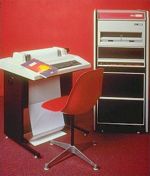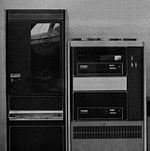PDP-11/05
| PDP-11/05 | |
| Manufacturer: | Digital Equipment Corporation |
|---|---|
| Architecture: | PDP-11 |
| Year Introduced: | June 1972 |
| Word Size: | 16 bit |
| Physical Address Size: | 18 bits (only 16 bits usable) |
| Bus Architecture: | UNIBUS |
The PDP-11/05 was the fourth model in the PDP-11 series, following the PDP-11/20, the PDP-11/45 and the PDP-11/40; it used the KD11-B CPU. It was intended as a cost-reduced low-end machine to replace the PDP-11/20. Like all the other early PDP-11's, it was a UNIBUS machine.
The PDP-11/05 was absolutely identical to the PDP-11/10; the only difference between the /05 and the /10 was the number printed on the front panel. The /05 was aimed toward the OEM market, while the /10 was intended for end-users. General usage (following DEC's lead) is to refer to all these machines as '11/05's.
The earliest units came in a 5-1/4" box, which had room for only a double system unit backplane. A later version, the /05N and /10N, came in a 10-1/2" BA11-D Mounting Box; the final /05S and /10S versions came in the 10-1/2" BA11-K Mounting Box.
Backplane versions
The PDP-11/05 and /10 came in three versions, with four different versions of the main backplane (the 9-slot system unit holding the two CPU cards). All have two slots for the KM11 card, plugged in to debug the CPU.
Original version
The original /05 and /10 came with backplanes wired to hold MM11-L 16 Kbyte core memory units. There were two different backplanes: one (called "Configuration 1" in DEC documentation) held two memory units, with one slot left for quad-height SPC devices. The other ("Configuration 2") held one memory unit, and provided four SPC slots; it could also hold a DF11 Communications Line Adapter to convert the asynchronous serial line console line to EIA RS-232.
Here are the slot assignments in the backplanes (as seen from the board insertion side of the backplane, not the wire-wrap pin side, as is common in DEC documentation) :
Configuration 1:
| Connector | ||||||
|---|---|---|---|---|---|---|
| Slot | A | B | C | D | E | F |
| 1 | M7260 CPU board #0 | |||||
| 2 | M7261 CPU board #1 | |||||
| 3 | G110 Memory Control | |||||
| 4 | G231 Memory Driver | |||||
| 5 | UNIBUS Terminator | H213/H214 Core stack | ||||
| 6 | G110 Memory Control | |||||
| 7 | G231 Memory Driver | |||||
| 8 | UNIBUS Out | H213/H214 Core stack | ||||
| 9 | KM11-1 | KM11-2 | SPC | |||
Configuration 2:
| Connector | ||||||
|---|---|---|---|---|---|---|
| Slot | A | B | C | D | E | F |
| 1 | M7260 CPU board #0 | |||||
| 2 | M7261 CPU board #1 | |||||
| 3 | G110 Memory Control | |||||
| 4 | G231 Memory Driver | |||||
| 5 | UNIBUS Terminator | H213/H214 Core stack | ||||
| 6 | Unused | SPC | ||||
| 7 | UNIBUS Out | SPC | ||||
| 8 | KM11-1 | KM11-2 | SPC | |||
| 9 | DF11 | SPC | ||||
Note that the slots are numbered from 1 at the start; this is the inverse of the numbering for these backplanes in some DEC documentation.
-N type
The /05N and /10N had a slightly different backplane, which had space for two MM11-L memory units, but deleted the SPC slot of the previous double MM11-L backplane, and replaced it with a slot to hold the dual-height M9970 console terminal cable board, and also a dual-height DF11.
Board locations (again, as seen from the board insertion side of the backplane) are:
| Connector | ||||||
|---|---|---|---|---|---|---|
| Slot | A | B | C | D | E | F |
| 1 | DF11 | M9970 | KM11-A | KM11-B | ||
| 2 | M7260 CPU board #0 | |||||
| 3 | M7261 CPU board #1 | |||||
| 4 | UNIBUS Terminator | H213/H214 Core stack | ||||
| 5 | G110 Memory Control | |||||
| 6 | G231 Memory Driver | |||||
| 7 | G110 Memory Control | |||||
| 8 | G231 Memory Driver | |||||
| 9 | UNIBUS Out | H213/H214 Core stack | ||||
Note that the two KM11 slots are at the other side of the backplane from the slots used for them in the 'Configuration 1' and 'Configuration 2' backplanes.
-S type
The /05S and /10S came with a backplane wired to hold an MM11-U 32 Kbyte core memory, and which provided three SPC slots. The layout (from the board insertion side) is:
| Connector | ||||||
|---|---|---|---|---|---|---|
| Slot | A | B | C | D | E | F |
| 1 | M7260 CPU board #0 | |||||
| 2 | M7261 CPU board #1 | |||||
| 3 | UNIBUS Terminator | SPC | ||||
| 4 | DF11 or M9970 | SPC | ||||
| 5 | KM11-1 | KM11-2 | SPC | |||
| 6 | G235 X-Y Drive | |||||
| 7 | H217-D Core Stack | |||||
| 8 | G114 Sense/Inhibit | |||||
| 9 | UNIBUS Out | M8293 Memory Control | ||||
Keys
Unlike all the other keyed PDP-11s, which use a cylindrical Ace key, the /05's (and /10s) use a normal flat Yale-type key. The original key is a Chicago Lock Company key, code "GRB 2"; this is cut 215, on a Chicago K5K or Ilco S1041T blank. If simply duplicating an existing key, Hillman Y11 and FR4 blanks may be used (both work, but one has to be trimmed a bit, length-wise).
Gallery
| v • d • e PDP-11 Computers and Peripherals |
|---|
| UNIBUS PDP-11s - PDP-11/20 • PDP-11/15 • PDP-11/35 • PDP-11/40 • PDP-11/45 • PDP-11/50 • PDP-11/55 • PDP-11/70 PDP-11/05 • PDP-11/10 • PDP-11/04 • PDP-11/34 • PDP-11/60 • PDP-11/44 • PDP-11/24 • PDP-11/84 • PDP-11/94 QBUS PDP-11s - PDP-11/03 • PDP-11/23 • PDP-11/23+ • MicroPDP-11/73 • MicroPDP-11/53 • MicroPDP-11/83 • MicroPDP-11/93 QBUS CPUs: LSI-11 • LSI-11/2 • KDF11-A • KDF11-B • KDJ11-A • KDJ11-B • KDJ11-D • KDJ11-E Buses: UNIBUS • UNIBUS map • SPC • MUD • EUB • QBUS • CD interconnect • PMI Also: PDP-11 architecture • PDP-11 Extended Instruction Set • FP11 floating point • PDP-11 Memory Management |
| UNIBUS CPUs: KA11 • KC11 • KB11-A • KB11-B • KB11-C • KB11-D • KD11-A • KD11-B • KD11-D • KD11-E • KD11-EA • KD11-K • KD11-Z • KDF11-U
Co-processors: FP11-A • FP11-B • FP11-C • FP11-E • FP11-F • KE44-A • FPF11 Chips: LSI-11 • KEV11-A • KEV11-B • KEV11-C • F-11 • KEF11-A • KTF11-A • T-11 • J-11 • FPJ11 CPU options: KE11-E • KE11-F • KJ11-A • KT11-C • KT11-D • KK11-A • KK11-B • KT24 • KTJ11-B Rare CPU options: KS11 Memory Protection and Relocation option • KT11-B Paging Option • KUV11 Writeable Control Store Front panels: KY11-A • KY11-D • KY11-J • KY11-LA • KY11-LB • KY11-P More on buses: UNIBUS and QBUS termination • Bus Arbitration on the Unibus and QBUS • CTI BUS PDT-11s - PDT-11/110 • PDT-11/130 • PDT-11/150 CTI PDP-11s - PRO-325 • PRO-350 • PRO-380 Other: FIS floating point • PDP-11 Commercial Instruction Set • PDP-11 stacks • PDP-11 family differences |


